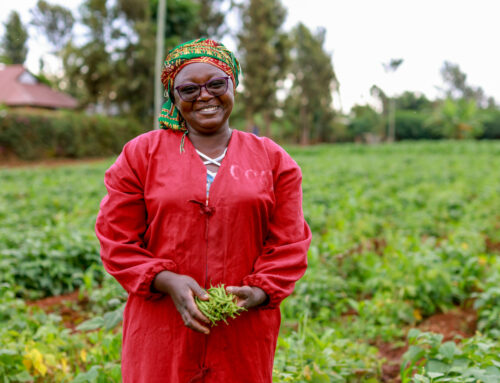Unlocking access to finance for agribusiness through innovation
Investing in the agricultural sector is often regarded as one of the most efficient and effective ways to promote food security and reduce poverty, but it is also a profitable business opportunity with massive growth potential. It’s estimated that the investment opportunity in agribusiness assets in emerging economies runs into the billions of dollars. Equally important, the need to invest in agriculture will only increase, due to rising global population and growing consumer preferences for higher value, quality, and safe foods. It’s estimated the demand for food will increase by 70% by 2050, and that meeting that demand will require at least $200 billion annually in investments.
Despite this opportunity, most small-scale agribusinesses in developing countries lack access to reasonable financing options for working capital and for acquiring productive assets. These companies fall into what is known as the “missing middle,” and face a combination of unrealistically high collateral requirements and unaffordable interest rates.
These businesses need reasonable financing options to, among other solutions, access improved inputs and acquire better on-farm practices so as to increase production. They also require financing to invest in post-harvest practices that can reduce food losses, improve the quality of products, and add value to the crops produced via processing. As the effects of climate change grow, agribusinesses will have to increasingly invest in sustainable production systems and climate adaptation technologies.
A farmers’ or agribusiness’ decision to invest is strongly influenced by his or her access to financial instruments. If appropriate financial instruments are lacking, or do not match the needs of the agribusiness, it may be discouraged from adopting technologies that can improve the efficiency of their businesses. In other words, productivity in the agricultural sector benefits from improved access for farmers and agribusinesses to financial instruments that are tailored to their needs.
Demand for finance in agriculture spans a range of different types of capital, from short-term trade finance to long-term debt and equity investment. Farmers and agro-enterprises require an assortment of capital to succeed. This includes, for instance, short-term working capital that farmers use to purchase farm inputs on a seasonal basis or that agribusinesses use to purchase raw materials from farmers or to operate a leased agro-processing facility. The need for finance also includes medium-term financing for farm or agro-processing equipment, as well as long-term debt and equity investments to acquire capital goods and land.
The particular conditions of agricultural businesses often require tailored financial products. This creates an opportunity for different types of financial intermediaries and providers of capital to develop innovative products and to play a variety of roles in addressing the unmet financial needs in the agriculture sector.
Nevertheless, finding the right investment opportunity is not easy. According to McKinsey, investing in the food and agribusiness sectors requires a high level of understanding of specific crops, geographies, and sometimes-complex value chains that encompass inputs, production, processing, and retailing. Additionally, many of the relevant investment opportunities are in geographies that are unfamiliar to a number of investors, and their profitability rests not only on crop yields but also on how different parts of the value chain perform (McKinsey, 2015).
However, sensing an opportunity, investors are moving fast to capture value from technological innovations and improved efficiencies in food and agriculture. Since 2004, global investment in the food-and-agribusiness sector has grown threefold to more than $100 billion in 2013, according to McKinsey analysis. Food-and-agribusiness companies on average have demonstrated higher total returns to shareholders (TRS) than many other sectors: the TRS of more than 100 publicly traded food-and-agribusiness companies around the world increased on average by 17 percent annually between 2004 and 2013, compared with 13 percent for energy and 10 percent for information technology companies.
The renewed investor interest in the agricultural business is leading to quicker innovations in agricultural finance. Many of these innovations are helping to dispel misplaced perceptions of risk associated with the sector by demonstrating fast commercially attractive returns and offering alternative options to risk-adverse finance conditions, such high collateral requirements, unaffordable interest rates and rigid repayment terms. Innovations in agriculture finance are building momentum for agricultural transformation in developing countries by mobilizing new resources, facilitating faster introduction of new technologies and addressing expensive barriers of traditional agricultural finance.
Here we list 7 emerging innovations occurring in agriculture finance and specifically targeting small and growing agribusinesses:
- The incorporation into credit risk assessments of information related to systemic risks, rather than just evaluating risks related to individual or the company, these assessments include information on the value chain that company operates within., involving those companies into the assessment through credit bureaus is facilitating de-risking diverse agricultural businesses. Also, the use of cash flows is reinforced for the calculation of financial viability, creditworthiness, and as a way agribusiness can demonstrate their capability to effectively utilize the asset and recover the investment.
- Asset finance makes it easier for businesses to acquire productive assets by using the asset being purchased (machinery or equipment for instance) as the collateral. These financing structures usually require that the asset be liquid enough—usually “movable”—so that it can act as its own collateral. Additionally, there must be a secondary market for the asset, and its resale value must be measurable. When asset finance options are unavailable, many agribusinesses must put up personal assets or find guarantors to meet collateral requirements.
- Leasing, similar to asset finance, provides financing for purchasing machinery or equipment. However, it uses an agreement between a “lessor” (financial institution) and the “lessee” (the client) that allows the lessee to access an asset for a predetermined amount of time in exchange for periodic payments. Leasing offers the opportunity for a business to finance productive assets largely on the basis of its ability to generate cash from operations rather than on its past credit experiences. The lessors, in turn, have partnerships with technology suppliers that provide services and secondary markets for the equipment.
- Factoring is a form of short-term financing by which a company sells its accounts receivable (A/R) to a bank or factoring company at a discount. This “sale” occurs only once a company has delivered goods to a customers but cash payment is still forthcoming. The company selling its A/R benefits by receiving cash earlier than it would from its customer under the terms of the receivable, and is thus able to immediately utilize that cash to meet its working capital needs. Factoring can also provide important export services to agribusinesses.
- Value chain finance addresses the working capital needs of companies participating along a value chain. There’s a growing network of financial institutions dedicated to working with specific value chains, often lending to small farmers who have little experience with banks and formal financing. The business model is anchored by relationships with larger firms that source from smaller farmers. The presence of secure purchase contracts from buyers in the agricultural sector can guarantee a stable revenue stream for supplying farmers, and in turn, incentivize financial institutions to lend to the latter. Financing models like this that rely on buyers as the repayment source are based upon an analysis of the overall value chain and the strong business relationships within it.
- Agricultural technology companies are also becoming important financiers, and are establishing their own or co-shared funds for providing finance directly to their clients. A new practice applied by these companies is to provide manageable payment terms to customers that guarantee repayment while also providing some flexibility in the early stages of using the new asset. Agtech companies might provide more flexible on repayment dates (every quarter or semester) to reflect the seasonality of cash flows or transfer equipment property only once repayment is complete.
- New information systems for agricultural risk management (such as remote sensing systems) are allowing to access to real-on-time information about production, prices and conditions. This is key to assess farming and agribusiness risks and to find the most appropriate risk management strategies. For financial institutions, these systems are helping to build more confidence in the sector and to back-up less strict lending conditions. Monitoring client’s production outcomes is difficult in rural areas. If financial providers are unable to track their clients, they might be less willing to engage with the sector or to address that risk by severely rationing credit or relying too heavily on traditional risk mitigation mechanisms.
Here you will find a list of investors and financiers with orientation into agribusiness sector. If you need further information or an introduction to any of these organizations, you can write to prodriguez@epven.com.
| Organizations | Type of capital | Region of focus | Target area |
| Root Capital | Debt | Global | Agriculture & agribusiness |
| AECF | Grant & debt | East, West & South Africa | Agriculture & agribusiness |
| Lendable | Debt, asset finance | East Africa | Agriculture & agribusiness |
| Oiko Credit | Debt & equity | Global | Agriculture & agribusiness |
| Voxtra | Debt & equity | East Africa | Agriculture & agribusiness |
| Pearl Capital | Debt & equity | East Africa | Agriculture & agribusiness |
| Open Road Alliance | Grant & debt | Global | General impact investing, agribusiness is part of the portfolio |
| DOB Equity | Equity | East Africa | Agriculture & agribusiness |
| Novastar Ventures | Equity | East Africa | Technology applications to agriculture |
| AHL Venture Partners | Equity | East, West & South Africa | General impact investing, agribusiness is part of their portfolio |
| Acumen | Equity | Global | General impact investing, agribusiness is part of their portfolio |
| Pomona Capital | Debt & equity | Latin America | General impact investing, agribusiness is part of their portfolio |
| Rabobank Foundation | Debt & equity | Global | Agriculture & agribusiness |
| Ceniarth LLC | Debt & equity | Global | General impact investing, agribusiness is part of their portfolio |
| Equity Bank | Debt | Kenya | Commercial banking, agribusiness is part of their portfolio |
| Chase Bank Kenya Limited | Debt | Kenya | Commercial banking, agribusiness is part of their portfolio |
| Crossboundary | Debt & equity | East & South Africa | Energy tech, applications to agriculture |
| EFTA Equipment Loans | Leasing | East Africa | Agriculture & agribusiness |
| One Acre Fund | Asset-based debt | East Africa | Agriculture & agribusiness |
| SunFunder | Debt | East Africa | Energy tech, applications to agriculture |
| Doen Foundation | Grants, debt & equity | Global | General impact investing, agribusiness is part of their portfolio |
| Innovare Advisors | Leasing | East Africa | Agriculture & agribusiness |
| AgDevCo | Debt | East, West & South Africa | Agriculture & agribusiness |
| Juhudi Kilimo | Debt | East Africa | Agriculture & agribusiness |
| Pymwymic | Grant, debt, equity | Global | General impact investing, agribusiness is part of their portfolio |
| Energy Access Ventures | Equity | West & East Africa | Energy tech, applications to agriculture |
| Factor(E) Ventures | Equity | East Africa & India | Energy tech, applications to agriculture |
| Grassroots Business Fund | Debt & equity | Global | General impact investing, agribusiness is part of their portfolio |



